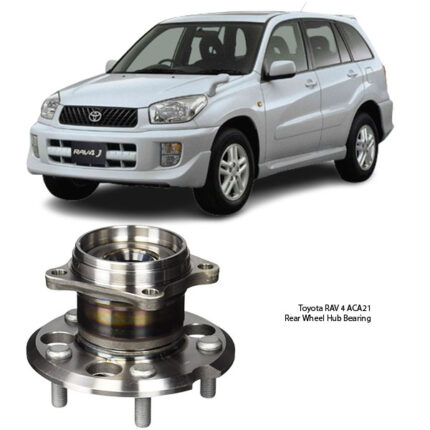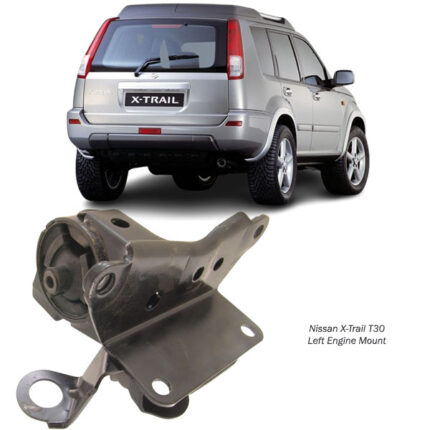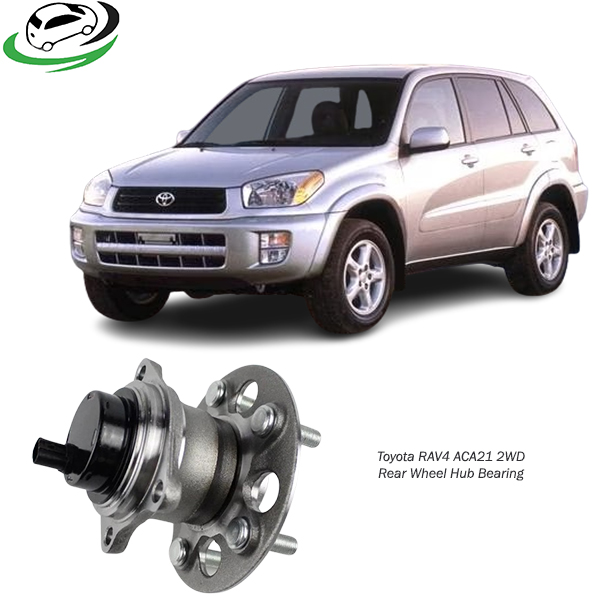-6%
Get Toyota RAV4 ACA21 2WD Rear Wheel Hub Bearing 42450-42030
The rear wheel hub bearing is a critical component in the automotive wheel assembly that plays a significant role in vehicle performance, safety, and ride comfort. As a crucial part of the wheel’s support structure, the rear wheel hub bearing allows for smooth rotation of the wheel while supporting the vehicle’s weight and absorbing road impacts. This detailed overview will explore the structure, function, benefits, symptoms of wear, maintenance, and replacement of rear wheel hub bearings, providing a comprehensive understanding of their importance in a vehicle’s operation.
Structure of Rear Wheel Hub Bearing
The rear wheel hub bearing consists of several key components:
- Outer Race:
- The outer race is the part of the bearing that sits in the wheel hub. It provides a surface for the rolling elements to travel against and is secured to the hub assembly.
- Inner Race:
- The inner race fits onto the axle shaft. It is attached to the wheel and rotates with it, providing a surface for the rolling elements to maintain their motion.
- Rolling Elements:
- These are typically ball bearings or tapered roller bearings situated between the inner and outer races. They enable smooth rotation and reduce friction between the rotating parts.
- Cage:
- The cage holds the rolling elements in place and ensures proper spacing and alignment, preventing them from coming into contact with each other.
- Seals:
- Seals are crucial for protecting the bearing from contaminants such as dirt, dust, and moisture. They help maintain lubrication within the bearing and prevent premature wear.
- Grease:
- The bearing is filled with high-quality grease that provides lubrication, reducing friction and wear during operation.
Functions of Rear Wheel Hub Bearing
The rear wheel hub bearing serves several important functions in a vehicle’s operation:
- Support Vehicle Weight:
- The bearing supports the entire weight of the vehicle at the rear, enabling it to handle various loads, including passengers, cargo, and towing.
- Facilitate Wheel Rotation:
- The primary function of the rear wheel hub bearing is to allow smooth and efficient rotation of the wheel. This is crucial for vehicle mobility and performance.
- Ensure Stability:
- A properly functioning rear wheel hub bearing contributes to overall vehicle stability. It helps maintain the correct alignment of the wheels, which is essential for safe handling.
- Absorb Shock:
- The rear wheel hub bearing absorbs shocks and vibrations from the road surface, enhancing ride comfort for passengers and reducing wear on other suspension components.
- Noise Reduction:
- A well-maintained bearing minimizes noise generated during wheel rotation, contributing to a quieter cabin experience for the occupants.
Benefits of Using Quality Rear Wheel Hub Bearings
Investing in high-quality rear wheel hub bearings offers several benefits:
- Enhanced Safety:
- Quality bearings provide reliable performance, reducing the risk of wheel failure, which can lead to dangerous driving conditions and accidents.
- Improved Handling:
- High-quality bearings ensure smooth wheel rotation and proper alignment, leading to better handling characteristics and improved overall vehicle performance.
- Longevity:
- Durable materials and construction in quality bearings ensure longevity, reducing the frequency of replacements and associated costs.
- Reduced Maintenance:
- Quality rear wheel hub bearings often require less maintenance, saving time and money in the long run.
- Noise Reduction:
- Premium bearings operate quietly, contributing to a more pleasant driving experience by minimizing unwanted road noise.
Common Signs of Wear and Failure
Recognizing the symptoms of a failing rear wheel hub bearing is crucial for maintaining vehicle safety. Common signs include:
- Grinding or Rumbling Noise:
- A distinct grinding or rumbling sound coming from the rear wheels while driving can indicate a worn or damaged bearing. This noise typically increases with speed.
- Vibration or Wobbling:
- If the vehicle experiences vibrations or a wobbling sensation while driving, it may be a sign of a failing rear wheel hub bearing or improper wheel alignment.
- Uneven Tire Wear:
- Worn bearings can lead to misalignment, causing uneven tire wear. Inspect the tires regularly for signs of excessive wear on one side.
- Difficulty Steering:
- A failing rear wheel hub bearing may affect steering responsiveness, leading to difficulty controlling the vehicle, especially during turns.
- ABS Warning Light:
- In vehicles equipped with an Anti-lock Braking System (ABS), a failing wheel hub bearing can trigger the ABS warning light on the dashboard.
- Play in the Wheel:
- Excessive play or looseness in the rear wheel can indicate bearing wear. This can be checked by lifting the vehicle and shaking the wheel to assess any movement.
Maintenance of Rear Wheel Hub Bearings
Regular maintenance is essential to ensure the longevity and performance of rear wheel hub bearings. Here are some key maintenance tips:
- Regular Inspections:
- Periodically inspect the wheel bearings for signs of wear or damage. This includes checking for unusual noises, vibrations, or any visible wear on the wheel hub assembly.
- Proper Wheel Alignment:
- Have the vehicle’s wheel alignment checked regularly, especially after replacing suspension components or tires. Proper alignment helps reduce strain on the bearings.
- Lubrication:
- Ensure that the bearings are properly lubricated. Some modern wheel bearings are sealed and do not require additional lubrication, but it’s essential to check the manufacturer’s recommendations.
- Dust Seal Integrity:
- Inspect the dust seals for cracks or damage. Replacing damaged seals promptly can help protect the bearings from dirt and moisture, extending their lifespan.
- Tire Rotation:
- Regularly rotate the tires according to the manufacturer’s recommendations. This helps ensure even wear and can prevent undue strain on the wheel bearings.
- Avoid Overloading:
- Do not exceed the vehicle’s load capacity. Overloading can put excessive stress on the rear wheel hub bearings, leading to premature wear.
Replacement of Rear Wheel Hub Bearings
If wear or failure is detected, timely replacement of the rear wheel hub bearings is essential. Here’s a general overview of the replacement process:
- Safety Precautions:
- Always prioritize safety. Use jack stands to secure the vehicle after lifting it and ensure the vehicle is on a level surface.
- Remove the Wheel:
- Start by removing the wheel to access the rear hub assembly. This typically involves loosening the lug nuts and using a jack to lift the vehicle.
- Remove Brake Components:
- Depending on the vehicle, you may need to remove brake calipers and rotors to access the hub bearing assembly.
- Detach the Hub Assembly:
- Remove the bolts securing the hub assembly to the suspension components and the axle shaft. Carefully detach the hub assembly from the vehicle.
- Replace the Bearing:
- Remove the old bearing from the hub assembly. Clean the hub surface and install the new bearing, ensuring it is properly seated.
- Reassemble:
- Reattach the hub assembly to the suspension, reinstall the brake components, and put the wheel back on. Torque the lug nuts to the manufacturer’s specifications.
- Test Drive:
- After completing the installation, take the vehicle for a test drive to ensure that the new bearing operates smoothly and that there are no unusual noises or handling issues.
Conclusion
The rear wheel hub bearing is a vital component that contributes to the safety, performance, and comfort of a vehicle. Understanding its structure, function, benefits, signs of wear, maintenance, and replacement can help vehicle owners make informed decisions regarding their vehicle’s upkeep. Regular inspections and timely replacements of rear wheel hub bearings can prevent serious safety issues and enhance the overall driving experience. Always consult a professional mechanic for inspections and replacements to ensure optimal performance and safety.
Follow us on Facebook for more parts.



